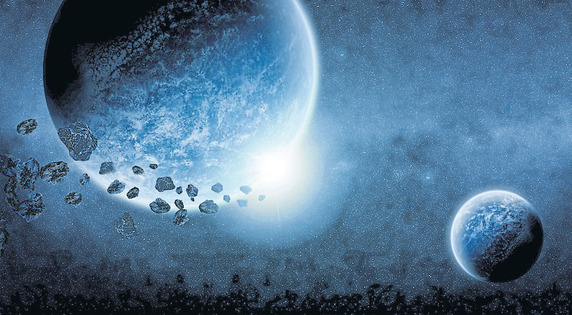The not-so-lonely planet?
In April astronomers announced the discovery of an earth-like planet.

It is 39 light years away with an atmosphere. Could this be an inhabited world? We are given the impression that aliens are everywhere. There are movies like ET, Independence Day or Close Encounters. There are books like War of the Worlds or The Hitchhiker’s Guide to the Galaxy. Classics among video games are Space Invaders and Defender.
Does the possibility of extra-terrestrial life present problems for the Christian faith? This question is not new. Christian theologians of the Middle Ages discussed the topic. More recently, C.S. Lewis gave some thought to this (Religion and Rocketry) alongside writing an intriguing trilogy of science fiction novels (Out of the Silent Planet, etc.).
UFOs and SETI?
Sightings of ‘unidentified’ flying objects became commonplace in the post-war period. It turned out that most could be identified with known natural or artificial causes, but just a few were classified as Unidentified and these UFOs were popularly linked to alien technology. An entire industry was born. But even in our present age of ubiquitous camera phones and Internet sharing we still lack definitive evidence of extra-terrestrial craft and scientists turn elsewhere to find evidence of alien life.
SETI, or the Search for Extra-Terrestrial Intelligence, includes a number of research projects scanning the universe for radio signals that could be the tell-tale sign of alien civilisations. In 1977 a signal was detected. Now dubbed the ‘Wow!’ signal, a word hastily scrawled on the computer printout, it remains the best candidate for an artificial signal. However, the signal has never been detected since, and there are many possible explanations for its origins that do not require aliens.
Improved telescopes
The search for alien life has now focussed on finding habitable planets beyond our solar system. With improvements in telescopes it is now possible to identify planets orbiting other stars. Ever-improving imaging and measuring techniques have made it possible to describe their size, orbit and even something of their atmosphere. This has led to a number being described as ‘earth like’. In August 2016, astronomers announced the discovery of Proxima b, a planet in the habitable zone and a mere three or four light years away. However, observations suggest that the planet does not rotate, but is locked in orbit around its sun. That plays havoc with temperatures and atmosphere. Complex life is unlikely on Proxima b.
Rare Earth
All these investigations into exoplanets keep leading us back to something called the Rare Earth hypothesis. This hypothesis draws attention to a startling fact: the more we explore the universe the more we realise that our home is something special.
The hypothesis has a number of scientific proponents including astronomers, palaeontologists and geologists. They list up to 200 features that we know are necessary for complex life. Like Goldilocks and her porridge, the earth must be in just the right place to be not too hot and not too cold. But that is just the start of the fussy requirements for complex life. We need to be in the right location in the galaxy, to have a stable orbit, plate tectonics and a very specific atmosphere. Even a large moon and the assistance of other planets in our solar system play a part. The moon provides tidal conditions which contribute to life. The giant gas planets vacuum up large comets and meteors that venture into our solar system. Without them our earth would receive more frequent comet impacts, devastating to life.
Life is astonishing
Rare Earth proponents draw attention to how highly improbable every factor is in the requirements for life. Put those improbabilities together and life is incredibly rare. While the vast number of stars in the universe gives the impression that life might be common, these factors indicate that life is astonishing. Critics may suggest that this hypothesis assumes that only carbon-based life like our own is possible. But other forms of life, silicon or boron based, or other environments (thermal vents) would be highly specialised and lack the conditions for complexity and diversity. It would make the mould on your cheese seem a more exciting companion.
The exploration of space remains an inspiring adventure and who knows what might be found? But, for all our investment into seeking life in the universe, we may be missing the obvious truth on our doorstep. Our world of crows and conifers, dolphins and dandelions is not only beautiful, but highly improbable. It is so special and unique it should make us wonder about our place in the universe. And about human life itself with the ability to invent, create, love, explore and discover. The real headline is that there is a place in this vast cosmos where there is complex life. David expressed this awe long ago in Psalm 8. Of God, he declared: ‘You have set your glory in the heavens’ and this leads him to ask: ‘What is mankind that you are mindful of them?’ The question raised by our rare earth finds an answer in the existence of a providential creator God.
Chris is the D.L. Moody Lecturer in Apologetics, Moorlands College.



